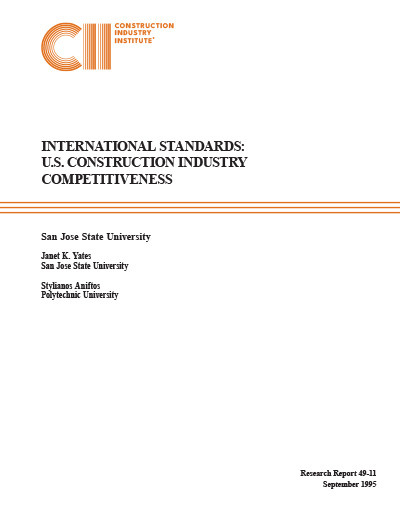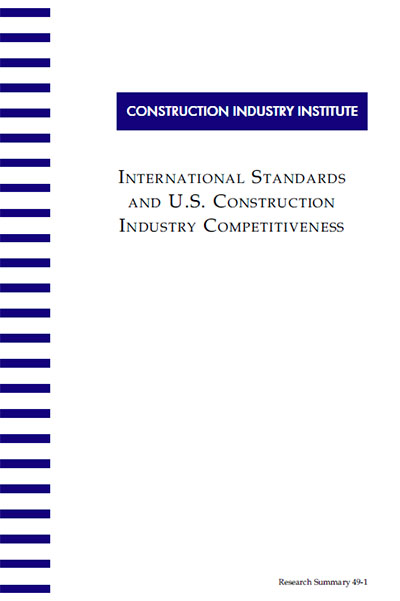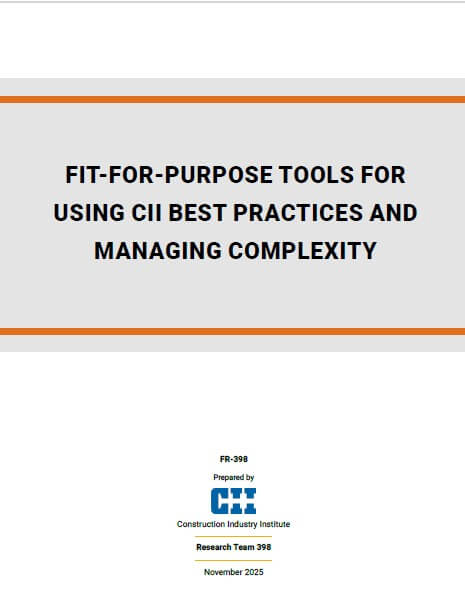
International Standards: U.S. Construction Industry Competitiveness
This document addresses issues related to the development and implementation of international standards that may impact the U.S. construction industry in the near future. It discusses the drivers for development of international standards, how industries in other countries are using standards to promote their competitiveness in an increasingly global economy, how they work with their respective governments to develop standards, how the U.S. construction industry is lagging behind in standards development, and the potential cost for this limited involvement. The ISO 9000 series of standards are also discussed as part of the immediate concern over the development of international standards.
Background
Standards are an important aid in the process of homogenizing the business world and in the past the U.S. had developed most of the standards being used throughout the world. In the U.S. there are currently 94,000 standards that are actively being maintained. The International Organization for Standardization (ISO) was formed in 1947 to promote the development of standardization and to facilitate the international exchange of goods and services and to foster cooperation between intellectual, scientific, technological, and economic activities. The technical work produced by ISO is published as international standards.
Current Status
There are currently 91 countries with committees involved in ISO, most of which are funded by their governments. One example of this involvement is in the area of electronic data transfer where the Taiwanese government has committed to spend $175 million and Korea has pledged $150 million for the development of standards. The U.S. government is not directly involved in the type of international standards funding that takes place in most other countries. In 1993, there were over 12,000 international standards listed in the ISO certified catalogue. There are 176 technical committees, 638 subcommittees, technical liaisons and approximately 400 international organizations, with an estimated 20,000 engineers, scientists, and administrators involved in the development of ISO standards. The U.S. is represented by the American National Standards Institute (ANSI) and the National Institute for Standards and Technology (NIST). ANSI does not develop standards which means the U.S. is allowing others to define the global standards that will govern international business in the future.
ISO 9000, a series of five system quality standards, has been adopted by the European Economic Community (EEC). Many businesses in Europe, and some worldwide, are now requiring ISO 9000 certification before they will consider doing business with a company. Currently over 40,000 European businesses have been certified in one of the ISO 9000 quality systems standards. It is estimated that some 500,000 U.S. firms currently exporting to the EC should be considering registration for compliance to the ISO 9000 standards series, yet a survey of American Manufacturers found that only 52 percent had ever even heard of these standards. Less than 5,000 company sites in the U.S have been registered, and few of these are engineering and construction firms.
Costs and Benefits
The costs associated with obtaining ISO certification include internal and external costs ranging from $10,000 to $600,000 and up to $100,000 respectively. The time required to obtain registration, from start to finish averages about one year and some firms have reported the process taking three years.
Cost savings of being registered are difficult for service organizations to quantify because the registration process is relatively new. Attributes such as market-share advantage, improving client perceptions, and better or improved systems are the most fre
Recovery time for cost registration can only be estimated since the certification system has only been in place for a limited time. Firms are estimating recovery from three years to 13 years years.
Results
The results section contains data obtained from a survey of 138 different organizations related to the construction industry. A questionnaire was used to gather information on the development of international standards, competitiveness issues, awareness of international standards, the importance of international standards, use of standards, and the importance and use of the ISO 9000 series of standards. The ramifications of the results of the survey are also discussed in this section.
Conclusions
Instead of continuing to use many of the U.S. standards that have been used in the past, other countries are now adopting ISO standards. This puts pressure on the U.S. to be more involved with the development of ISO standards if it is to remain competitive in the global market. Although there are many different standards and standards setting organizations involved in the development and implementation of international standards, there is little direct participation by members of firms from the U.S. construction industry except through private participation in trade, technical, and professional organizations. This document contains a concise summary of the processes required to develop and implement internationals standards and also explains the consequences of not being directly involved in standards development. This information will assist firms from the U.S. construction industry in determining their desired level of involvement in international standards activities in order to enhance their competitiveness in the international arena.
Recommendations
If the U.S does not continue to be a major presence in the arena for developing international standards they may be forced to eventually adopt standards that favor firms from other countries or that could prevent them from operating in other countries altogether.



